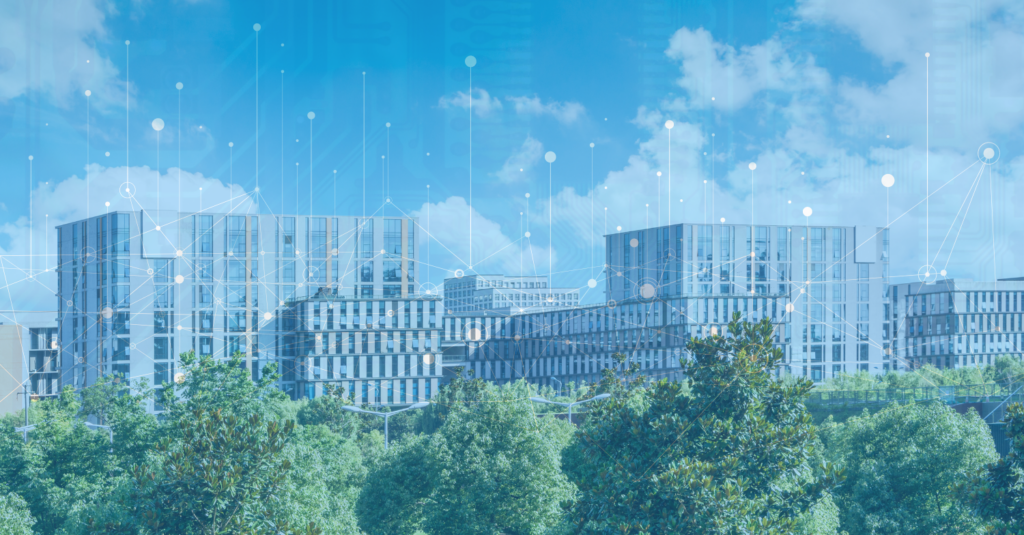Understanding the Built Environment’s Impact
The built environment is often overlooked as a key contributor to environmental degradation. It includes everything we build as a society, from the homes we live in to the offices we work in, and the roads we travel on. Statistics reveal that the built environment generates 40% of annual global CO2 emissions (IEA) and of those total emissions, building operations are responsible for 27% annually. Building and infrastructure materials and construction compromise the additional 13%. These numbers underline the urgent need for implementing more sustainable practices across all phases of building management and urban planning.
Key Industry Trends Influencing Emissions:
- Increased demand for electricity: Higher average temperatures and extreme weather fluctuations with impacts on health and ability to work are driving the demand for more cooling than ever before, resulting in increased emissions. In addition, improved global standards of living and workplace conditions have upped the demand for new construction and thermal comfort, leading to higher electricity usage.
- Global building floor area expected to double by 2060: The growth in the average floor area of buildings associated with urbanization, rapid population growth, and economic growth has outpaced the improvements to the carbon intensity of buildings, causing absolute emissions from buildings to continue rising. The more floor area there is, the more heating and cooling is necessary per square foot.
- Low retrofitting rates: The rate at which existing buildings are being retrofitted to improve their energy efficiency and reduce their emissions is relatively low, despite the potential benefits of such improvements.
- COVID-19 Pandemic: The COVID-19 pandemic was a huge disruptor of the commercial real estate sector, and will continue to play a role in real estate trends for years to come as companies look to downsize and question their need for permanent office or commercial spaces at all. Now, as landlords and commercial real estate companies are in greater competition for tenants, commitments to sustainability and ESG can be a differentiating factor. In addition, despite initial data showing a decline in direct and indirect emissions from buildings in 2020 due to the pandemic rendering commercial building spaces useless for some time, the emissions rate has seen a full rebound to pre-pandemic levels in 2022.
The Role of Data in Sustainable Building Management
Intelligent data management transforms raw data into actionable insights that can lead to significant environmental and economic benefits. WatchWire’s platforms integrate seamlessly with existing building systems to monitor everything from energy usage to operational efficiency. For example, through advanced analytics, facility managers can detect anomalies in energy consumption that may indicate a need for equipment repairs or upgrades. Furthermore, real-time data monitoring allows for immediate adjustments to building operations, ensuring optimal performance with minimal waste.
In the pursuit of sustainability, certain metrics serve as critical indicators of a building’s environmental performance:
- Energy Use Intensity (EUI): This is a crucial metric that provides insights into the energy efficiency of a building by comparing total energy consumed relative to its size.
- Water Usage: Effective water management is increasingly important in regions facing water scarcity. Monitoring systems can help identify leaks and inefficiencies, saving significant amounts of water.
- Waste Management: Proper tracking of waste generation and disposal helps buildings reduce their environmental footprint and improve recycling rates.
- Greenhouse Gas Emissions: Measuring the carbon output of building operations is essential for setting reduction targets and complying with global climate agreements.
Advanced Strategies for Improving Building Sustainability
There are many ways to reduce greenhouse gas emissions from the commercial real estate sector. Across real estate portfolios, firms can start implementing energy efficiency projects, reducing water use, utilizing combined heat and power and renewable energy, and integrating the more efficient use and recycling of materials. To enhance sustainability, building managers can employ several advanced strategies:
- Retrofitting and Renovations: Updating older buildings with modern, energy-efficient technology and materials can dramatically reduce their environmental impact.
- Renewable Energy Solutions: Integrating solar panels, wind turbines, and other renewable energy sources to reduce dependency on fossil fuels.
- Smart Automation and Control Systems: Utilizing AI-driven automation systems to manage lighting, heating, ventilation, and air conditioning can optimize energy use and improve indoor environmental quality.
Regulatory Frameworks and Incentives
Understanding and navigating the complex landscape of environmental regulations is critical for building operators:
- Global and Local Regulations: Discuss the impact of international agreements like the Paris Accord alongside local building codes focused on sustainability.
- Certification Programs: Detail the benefits and requirements of obtaining certifications like LEED or BREEAM, which can also enhance a property’s market value.
- Incentives: Explore how various incentives, such as tax breaks or subsidies, can make sustainable investments more affordable and appealing.
More About WatchWire
WatchWire by Tango is a market-leading, energy and sustainability data management platform that uses cloud-based software to collect, automize, and analyze utility, energy, and sustainability data metrics. WatchWire streamlines, automates, and standardizes your sustainability reporting process by integrating directly and/or providing reporting exports to ENERGY STAR Portfolio Manager, LEED Arc, GRESB, CDP, SASB, GRI, and more. The platform provides customizable dashboards, which allow asset managers, sustainability managers, engineers, and more to monitor individual key performance indicators (KPIs) and create custom views for specific use cases.
To learn more about WatchWire and its capabilities, you can visit our website, blog, or resource library, request a demo, or follow us on LinkedIn, Instagram, or Twitter to keep up-to-date on the latest energy and sustainability insights, news, and resources.
 Top Sustainability Trends to Watch in 2025
Top Sustainability Trends to Watch in 2025

 Log In
Log In









